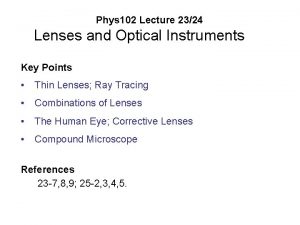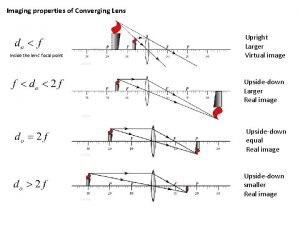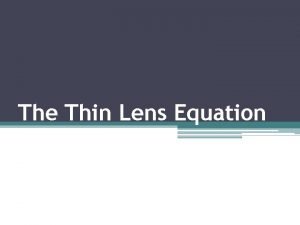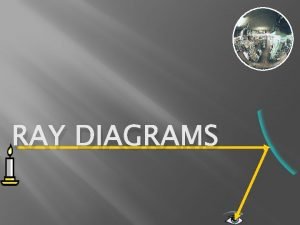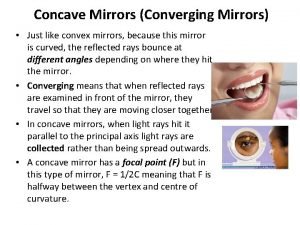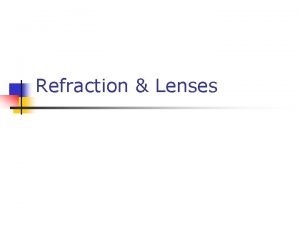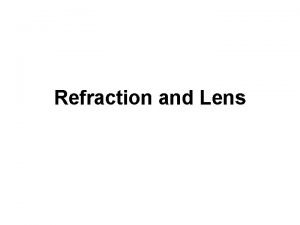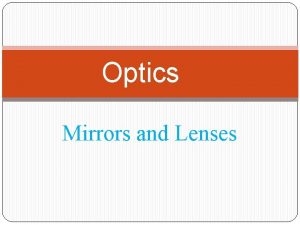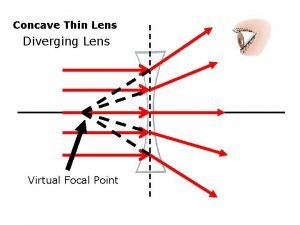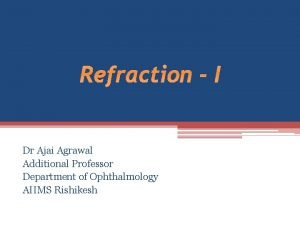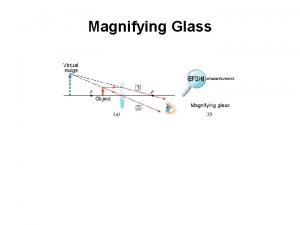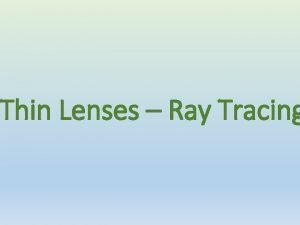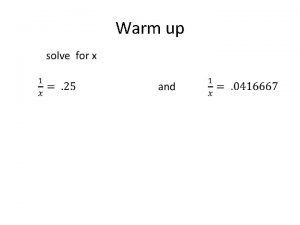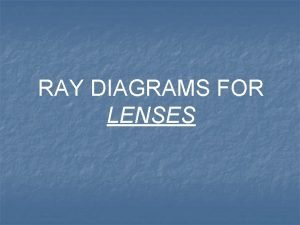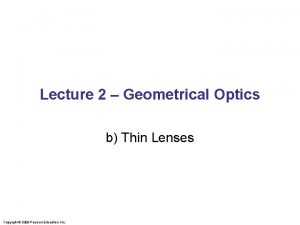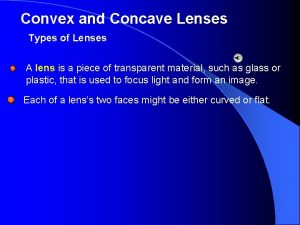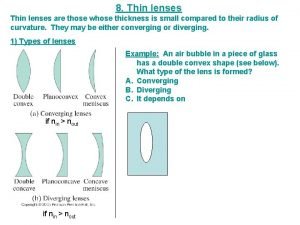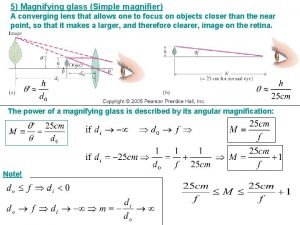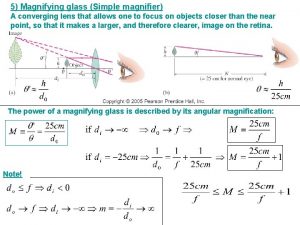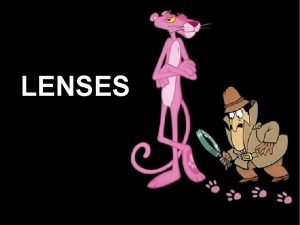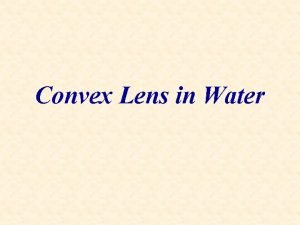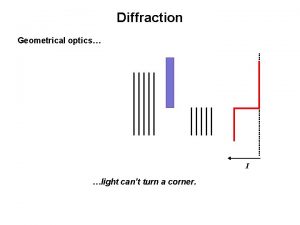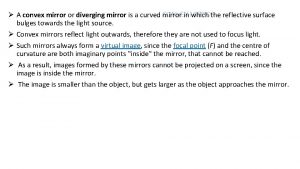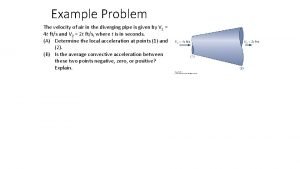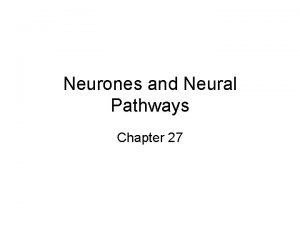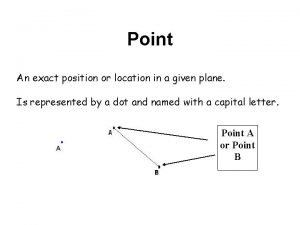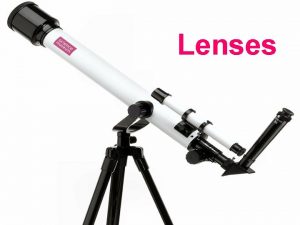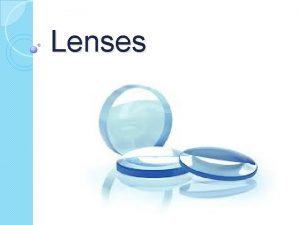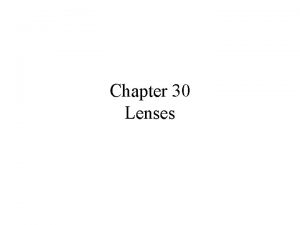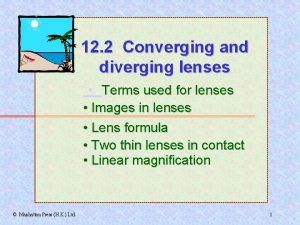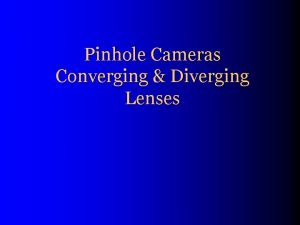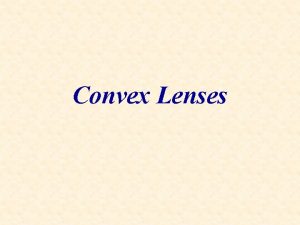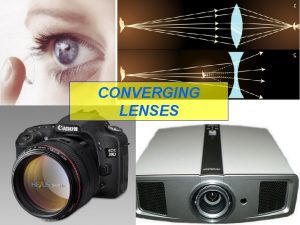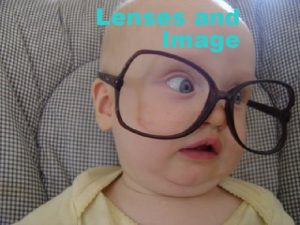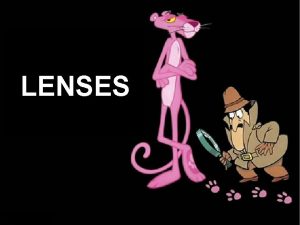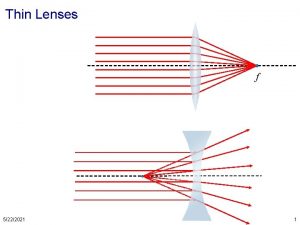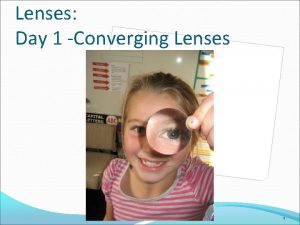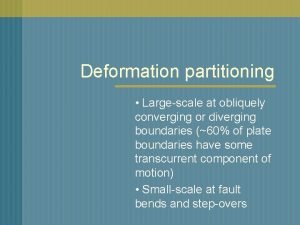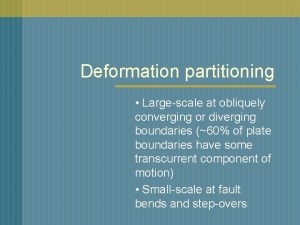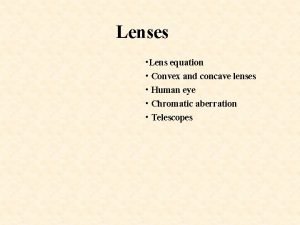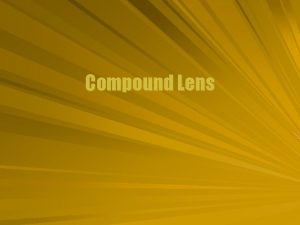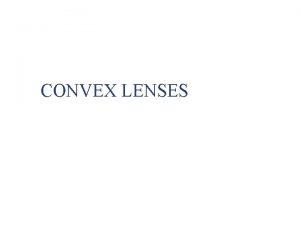Lenses Chapter 30 Converging and Diverging Lenses Lens


































- Slides: 34

Lenses Chapter 30

Converging and Diverging Lenses ¡ ¡ ¡ ¡ Lens – a piece of glass which bends parallel rays so that they cross and form an image Converging Lens – a lens which is thicker in the middle, makes parallel light rays converge Diverging Lens – a lens which is thinner in the middle, makes parallel light rays diverge Principle Axis – line joining the centers of curvature of a lens’ surface Focal Point – the point at which a beam of light converges Incident parallel beams that are not parallel to the principle axis focus at points above or below the focal point Focal Plane – all possible points from incident beams A lens has two focal points and two focal planes

Converging and Diverging Lenses

Image Formation by a Lens ¡ ¡ ¡ Magnification occurs when an image is observed through a larger angle with the use of a lens than with out the lens, and allows more detail to be seen A converging lens will only magnify when the object is between the focal point and the lens Virtual Image – an image formed through reflection or refraction that can be seen by an observer but cannot be projected on a screen because light from the object does not actually come to a focus Real Image – an image that is formed by converging light rays and that can be displayed on a screen When a diverging lens is used alone, the image is always virtual, right-side up, and smaller than the object

Image Formation by a Lens

Constructing Images Through Ray Diagrams ¡ ¡ ¡ 1. 2. 3. Ray Diagrams – show the principle rays that can be used to determine that size and location of an image One end of the object is always placed right on the principle axis 3 useful rays in ray diagrams Ray parallel to the principle axis that passes through the focal point after refraction by the lens A ray through the center of the lens that does not change direction A ray through the focal point in front of the lens that emerges parallel to the principle axis after refraction by the lens

Constructing Images Through Ray Diagrams

Image Formation Summarized ¡ ¡ If an object is one focal length away from a converging lens, the image is virtual, magnified, and right-side up If an object is beyond one focal length, a converging lens produces a real, inverted image If the object is close to the focal point, the image appears far away; if it is far from the focal point, the image appears nearer When an object is viewed through a diverging lens, the image is virtual, reduced, and right-side up

Some Common Optical Instruments ¡ ¡ The Camera – consists of a lens and sensitive film mounted in a lighttight box, the amount of light which gets to the film is regulated by a shutter and a diaphragm (which varies the size of the opening) The Telescope – a simple telescope uses a lens to form a real image of a distant object The Compound Microscope – uses two converging lenses of short focal length, forming a real and a virtual image (so we see the object right-side up) The Projector – An arrangement of converging lenses is used

Some Common Optical Instruments

The Eye ¡ ¡ ¡ The amount of light that enters is regulated by the iris, the colored part of the eye that surrounds the opening called the pupil Light enters through the transparent covering called the cornea, passes through the pupil and lens, and is focused on a layer of tissue at the back of the eye —the retina—extremely sensitive to light In both the camera and the eye, the image is upside down, our brain flips the image right-side up for us

The Eye

Some Defects in Vision Farsighted – person’s eyes form images behind the retina, the eyeball is too short ¡ Nearsighted – person’s eyes form images in front of the retina, the eyeball is too long ¡ Astigmatism – the cornea is curved more in one direction than the other, the eye does not form sharp images ¡

Some Defects in Vision

Some Defects in Lenses ¡ ¡ Aberrations – the distortions in an image By combining lenses in certain ways, aberrations can be minimized Spherical aberration results when light passes through the edges of a lens and focuses at a slightly different place from light passing through the center of the lens Chromatic aberration is the result of the different speeds of light of various colors and hence the different refractions they undergo

Some Defects in Lenses

Diffraction and Interference Chapter 31

Huygen’s Principle – every point on any wave can be regarded as a new point source of secondary waves ¡ As a wave front spreads, it appears less curved ¡ Very far from the original source, the wave fronts seem to form a plane ¡ You can observe Huygen’s principle in water waves that are made to pass through a narrow opening ¡

Huygen’s Principle

Diffraction ¡ ¡ ¡ Diffraction – any bending of a wave by means other than reflection or refraction When the opening is wide compared with the wavelength, the spreading effect is small As the opening becomes narrower, the spreading of waves becomes more pronounced Diffraction is not confined to the spreading of light through narrow slits or other openings, but occurs to some degree with all shadows The amount of diffraction depends on the size of the wavelength compared with the size of the obstruction that casts the shadow

Diffraction

Interference Pattern – at least two sets of waves create a pattern where wave effects are increased, decreased, or neutralized ¡ Constructive Interference – individual effects add together ¡ Destructive Interference – individual effects are reduced ¡ Water waves can be produced in shallow tanks of water known as ripple tanks ¡

Interference

Young’s Interference Experiment ¡ ¡ Thomas Young discovered that when monochromatic light (light of a single color) was directed through two closely spaced pinholes, fringes of brightness and darkness were produced The bright fringes of light resulted from light from both holes arriving crest to crest The dark areas resulted from light waves arriving trough to crest Diffraction Grating – a multitude of closely spaced parallel slits

Young’s Interference Experiment

Single-Color Interference from Thin Films ¡ ¡ Interference fringes can be produced by the reflection of light from two surfaces that are very close together You’ll see dark and bright bands when shining monochromatic light on two plates of glass on top of each other The light that has to hit the second surface, has longer to go to hit your eye, so you see the interference between the surfaces Scientists use this in the testing of high precision lenses

Single-Color Interference from Thin Films

Iridescence from Thin Films ¡ ¡ ¡ Iridescence – the phenomenon whereby interference of light waves of mixed frequencies reflected from the top and bottom of thin films produces a spectrum of color A thin film, such as a soap bubble, has two closely spaced surfaces Light that reflects from one surface, may cancel out the light that reflects from the second surface The different colors in the bubble correspond to the cancellations of their complementary colors by different thicknesses of the film Interference provides the principle method for measuring the wavelengths of light

Iridescence from Thin Films

Laser Light ¡ ¡ ¡ The light from a common lamp is incoherent, has many phases of vibration Even if a beam has been filtered to be monochromatic, it is still incoherent because the waves are out of phase and interfere with one another A beam of light that has the same frequency, phase, and direction is said to be coherent, there is no interference of waves within the beam Coherent light is produced by a laser (light amplification by stimulated emission of radiation) The laser is not a source of energy, but a converter of energy

Laser Light

The Hologram – three-dimensional version of a photograph which contains the whole message or entire picture in every portion of its surface ¡ A hologram is produced by the interference between two laser light beams on photographic film ¡ One part illuminates the object and is reflected from the object to the film, the second part (the reference beam) is reflected from a mirror to the film ¡

The Hologram

Assignment Read Chapter 30 (pg. 463 -476) ¡ Do #15 -34 (pg. 478 -479) ¡ Read Chapter 31 (pg. 480 -498) ¡ Do #21 -31 (pg. 498) ¡
 Near point distance
Near point distance Image characteristics for converging lens
Image characteristics for converging lens Thin lens equation magnification
Thin lens equation magnification Converging-diverging
Converging-diverging Diverging lens diagram
Diverging lens diagram Convex mirror salt
Convex mirror salt Single pass tubular heater
Single pass tubular heater Accommodation eye
Accommodation eye Lens ray diagram
Lens ray diagram Nearsighted diverging lens
Nearsighted diverging lens Regular reflection
Regular reflection Virtual focal point
Virtual focal point Staphyloma
Staphyloma Lens used as magnifying glass
Lens used as magnifying glass A lens produces a sharply focused
A lens produces a sharply focused Lens equation worksheet
Lens equation worksheet Convex lens ray diagram
Convex lens ray diagram Converging lens equation
Converging lens equation Convex vs concave lens
Convex vs concave lens Thin converging lens
Thin converging lens Simple magnifier
Simple magnifier Magnifying glass converging lens
Magnifying glass converging lens Convex shape image
Convex shape image Converging lens in water
Converging lens in water Fraunhofer and fresnel diffraction
Fraunhofer and fresnel diffraction V
V Diverging evolution
Diverging evolution It is the inner terminus of the fingerprint pattern
It is the inner terminus of the fingerprint pattern Diverging evolution
Diverging evolution Convex mirror is a diverging mirror
Convex mirror is a diverging mirror The velocity of air in the diverging pipe shown
The velocity of air in the diverging pipe shown Diverging data flow
Diverging data flow The cell body
The cell body Angles directly across from each other
Angles directly across from each other Tear stream aspen plus
Tear stream aspen plus
